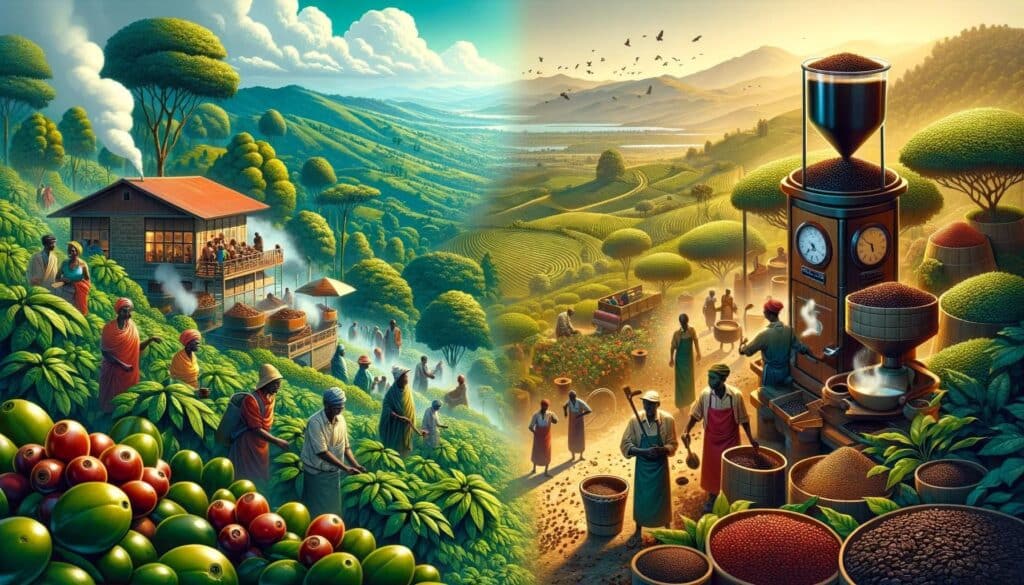From the bustling streets of New York City to the serene terraces of a Parisian café, from the aromatic coffee farms of Colombia to the traditional coffee houses of Turkey, coffee is more than just a beverage; it’s a global phenomenon that transcends borders and cultures. Revered for its stimulating properties and cherished for its comforting warmth, coffee has become an indispensable part of daily life for millions around the world. Its widespread popularity is not just about the caffeine kick; it’s about the experiences, rituals, and traditions that come with every cup.
But what makes coffee so universally adored yet uniquely experienced across different geographies? This article, “Coffee Cultures: A Global Journey,” seeks to explore just that. We will embark on an aromatic journey around the world, delving into the diverse ways in which coffee is grown, brewed, and enjoyed. From the birthplace of coffee in Ethiopia to the trendy espresso bars of Italy, from the precision of Japanese coffee art to the laid-back coffee shops of Australia, each stop on our journey will reveal a new facet of coffee culture.
In exploring these global coffee cultures, we aim not only to understand how coffee is consumed but also to appreciate the cultural significance behind each cup. Whether it’s a morning ritual, a reason to gather with friends, or a drink that fuels discussions and ideas, coffee has a unique way of reflecting and shaping the societies that embrace it. So, grab your favorite cup of joe, and let’s embark on this caffeinated journey around the globe.
The Roots of Coffee: Ethiopia and Yemen

The Birthplace – Ethiopia
Historical Origins of Coffee
Ethiopia, often hailed as the birthplace of coffee, holds a deep and mystical history with the coffee bean. Legend speaks of Kaldi, an Ethiopian goat herder who discovered the energizing effects of the coffee cherries after observing his goats becoming unusually spirited upon consuming them. This discovery, cloaked in myth and folklore, marks the beginning of coffee’s journey. The beans, initially valued for their stimulating properties, were consumed in various forms, from raw cherries to a wine-like drink.
As coffee plants flourished in the Ethiopian highlands, they became an integral part of the local culture and economy. The genetic diversity of coffee in Ethiopia is unmatched, giving rise to numerous varieties, each with distinct flavors and characteristics. This rich heritage sets the stage for Ethiopian coffee, not just as a drink, but as a symbol of national pride and natural bounty.
Traditional Ethiopian Coffee Ceremony
More than a beverage, coffee in Ethiopia is a ceremonial affair, deeply woven into the social and cultural fabric of the country. The Ethiopian coffee ceremony is an elaborate ritual, a symbol of hospitality and community. It begins with the roasting of green coffee beans over an open flame, filling the air with rich, aromatic scents. The roasted beans are then ground using a mortar and pestle and brewed in a traditional pot known as a ‘jebena.’
Guests are invited to partake in this ritual, often accompanied by the burning of incense and the serving of small snacks. The coffee is served in small cups, and the ceremony is repeated three times, with each round signifying a deeper level of spiritual connection. This ritual is not just about savoring a cup of coffee; it’s a time-honored tradition that fosters community bonds and offers a moment of reflection and togetherness.
Yemen’s Influence
Yemen’s Role in Coffee History
While Ethiopia is the birthplace of coffee, Yemen is where coffee was first cultivated and traded on a significant scale. In the 15th century, Sufi monks in Yemen began cultivating coffee plants in terraced farms in the mountains of Yemen. They prized coffee for its ability to keep them awake during long hours of prayer, thus beginning the global journey of coffee as a stimulant and a communal beverage.
Yemen’s port city of Mocha became a pivotal hub in the coffee trade, giving its name to the famous Mocha coffee bean, renowned for its distinctive flavor. For centuries, Yemen had a monopoly on coffee cultivation, with its methods and practices spreading across the Arabian Peninsula and beyond.
Introduction of Coffee to the Islamic World
The introduction of coffee to the Islamic world had profound cultural and social implications. Coffee houses, known as ‘qahveh khaneh,’ sprouted across the Middle East, becoming centers of social interaction, intellectual debate, and artistic expression. These establishments played a crucial role in the cultural and political life of cities, often attracting scholars, poets, and even politicians.
The spread of coffee within the Islamic world was not without controversy. Some religious authorities viewed the stimulating effects of coffee with suspicion, leading to periodic bans. However, the popularity of coffee prevailed, and it eventually became an integral part of social life in the Islamic world, setting the stage for its global spread to Europe and beyond.
European Coffee Traditions

Italian Coffee Mastery
Espresso and its Significance
The heart of Italian coffee culture lies in a single, potent brew: the espresso. This small, concentrated shot of coffee, characterized by its rich flavor and creamy foam (crema), is more than just a drink in Italy; it’s an emblem of Italian culinary ingenuity. The invention of the espresso machine in the early 20th century revolutionized coffee brewing, making it a quick, yet artful process. Espresso forms the base of numerous popular coffee drinks, including cappuccino, latte, and macchiato, each an integral part of Italy’s vibrant coffee culture.
Espresso in Italy is not just about taste; it’s about a ritual and a moment of pause. Whether sipped quickly at the bar or enjoyed leisurely at a café, it’s a cherished Italian custom, a time to recharge, reflect, or engage in lively conversation. The significance of espresso extends to its influence on coffee cultures worldwide, setting the standard for quality and technique in coffee brewing.
The Culture of Italian Coffee Bars
Italian coffee bars, or ‘caffè,’ are ubiquitous and vital social hubs in Italy. These establishments, ranging from elegant, historic cafés to simple, neighborhood bars, are integral to daily life. The Italian coffee bar is a place of community and camaraderie, where locals gather not just for a quick espresso but to catch up on news, debate local issues, or simply to enjoy the company of friends.
The etiquette and atmosphere in Italian coffee bars are unique. Ordering coffee is often a swift affair, with many Italians preferring to drink their espresso standing at the bar, engaging in brief, spirited exchanges with the barista. The coffee bar in Italy is more than a place to get a caffeine fix; it’s a cultural institution, a testament to the Italian way of life where the art of coffee is interwoven with the art of conversation and social connection.
The French Café Scene
History of Cafés in France
The café culture in France, particularly in Paris, has a storied history dating back to the 17th century. The opening of the first café in Paris marked the beginning of a new social era. French cafés quickly developed into well-liked gathering places with a diverse clientele, ranging from intellectuals and artists to politicians and regular people.
These cafés were not just places to enjoy a cup of coffee; they were venues for intellectual debate, literary discourse, and cultural development. The café scene in France became synonymous with the Enlightenment, playing a pivotal role in shaping French society and thought. The tradition of café terraces, with their iconic rattan chairs facing the street, became a hallmark of Parisian life, reflecting the café’s role as a place to observe, engage, and participate in the vibrant tapestry of city life.
The Role of Cafés in French Society and Literature
French cafés have long been intertwined with the country’s literary and artistic heritage. Legendary figures such as Voltaire, Sartre, and Hemingway were known for frequenting Parisian cafés, where they wrote, debated, and drew inspiration. These establishments became known as the informal salons of the modern era, where ideas were exchanged, and movements were born.
The café in France extends beyond a mere dining venue; it is a cultural symbol, representing the French values of leisure, conversation, and the enjoyment of the finer things in life. The prominence of cafés in French literature and art underscores their influence on the national psyche, immortalizing them as spaces where creativity, philosophy, and the joy of living converge.
Coffee in the Americas

The Starbucks Revolution – USA
The Rise of Starbucks and its Impact on Coffee Culture
The story of coffee in the United States is inextricably linked to the rise of Starbucks, a small Seattle coffee shop that transformed into a global phenomenon. Founded in 1971, Starbucks redefined the American coffee experience, turning it from a mere commodity into an upscale, culturally significant beverage. This revolution pivoted around the concept of the coffeehouse as a “third place,” a comfortable, social space between work and home.
Starbucks’ impact on coffee culture is multifaceted. It popularized espresso-based drinks such as lattes and frappuccinos, introduced the concept of customizable coffee, and made the coffee shop an integral part of everyday American life. The ubiquitous presence of Starbucks, with its distinctive branding and consistent product, has played a pivotal role in making coffee a globalized, accessible luxury.
The Third Wave Coffee Movement
In reaction to the commercialization and homogenization of coffee by chains like Starbucks, the late 1990s and early 2000s saw the emergence of the third wave coffee movement in the U.S. This movement treats coffee not just as a beverage, but as an artisanal food product, like wine, emphasizing quality, provenance, and flavor profiles.
Third wave coffee enthusiasts are characterized by their focus on single-origin beans, sustainable and ethical sourcing, and specialized brewing methods. This movement has given rise to a proliferation of independent coffee shops and roasters, where the emphasis is on craftsmanship, the story behind the coffee, and the experience of tasting. The third wave movement has significantly influenced global coffee culture, raising awareness about the complexities of coffee farming, production, and the importance of supporting sustainable and fair practices in the coffee industry.
Latin America’s Coffee Heritage
The Coffee Landscape in Countries like Brazil and Colombia
Latin America, home to some of the world’s most renowned coffee-producing countries, boasts a rich and varied coffee heritage. Brazil, as the world’s largest coffee producer, plays a significant role in the global coffee market, known for its vast coffee plantations and volume-driven production. Brazilian coffee is characterized by its nutty, chocolatey flavors, making it a staple in many blends.
Colombia, with its diverse microclimates and mountainous terrain, is celebrated for producing some of the finest Arabica beans. Colombian coffee is often synonymous with high quality, known for its smooth, mild flavor and balanced acidity. The country’s commitment to quality and its unique Coffee Cultural Landscape, recognized by UNESCO, underscore its significant role in the global coffee narrative.
Traditional Coffee Farming and Regional Varieties
Coffee farming in Latin America is deeply rooted in tradition, with generations of families dedicating themselves to cultivating coffee. The traditional farming methods often involve shade-grown coffee plants, which contribute to biodiversity and environmental sustainability.
Each region in Latin America offers distinct coffee varieties, shaped by the unique combinations of climate, soil, and altitude. For example, Guatemala is known for its complex, fruity coffees, while Costa Rica specializes in bright, citrusy flavors. The emphasis on regional varieties and artisanal production methods in these countries has greatly contributed to the diversity of coffee flavors available globally, offering coffee enthusiasts a rich palette of tastes and aromas to explore.
Coffee in Asia and the Pacific

The Japanese Coffee Phenomenon
Introduction of Coffee in Japan
The journey of coffee in Japan began in the late 19th century, a period marked by the country’s rapid modernization and openness to Western influences. Initially a luxury for the elite, coffee gradually permeated Japanese society, becoming a popular beverage across various social strata. The post-World War II era, in particular, saw a significant rise in coffee consumption, paralleling Japan’s economic growth and urbanization.
Japanese coffee culture is characterized by its fusion of traditional values with a keen interest in innovation and precision. This unique approach to coffee has led Japan to develop its distinct coffee practices and preferences, significantly contributing to the diversity of global coffee culture.
Unique Practices like Coffee Siphons and Kissaten
One of the most iconic elements of Japanese coffee culture is the use of coffee siphons, a brewing method that combines theatricality with precision. Siphon coffee, known for its clean, delicate flavor profile, is a testament to the Japanese pursuit of perfection in coffee brewing. This method, while originating in Europe, found a particular stronghold in Japan, where it is a symbol of the country’s fascination with both tradition and modernity in coffee preparation.
Kissaten, traditional Japanese coffee houses, are another cornerstone of Japan’s coffee culture. More than just cafés, kissaten are seen as cultural institutions, offering a serene, contemplative space for enjoying coffee and light fare. These businesses, frequently run by able owners, take pride in their artisanal approach to coffee, serving meticulously brewed drinks alongside a sense of history and nostalgia. Kissaten not only provide a respite from the bustling city life but also preserve the heritage and evolution of Japanese coffee culture.
The Australian Influence
The Emergence of Australian Café Culture
Australian café culture has emerged as a global phenomenon, characterized by its laid-back yet quality-focused approach to coffee. This culture, rooted in the cosmopolitan cities of Melbourne and Sydney, is a blend of traditional Italian espresso techniques and a modern, innovative spirit. The Australian love for coffee has created a vibrant café scene, known for its emphasis on high-quality beans, skilled baristas, and creative coffee offerings.
The café culture in Australia extends beyond the coffee itself; it encompasses a lifestyle that values leisure, conversation, and community. Australian cafés are often seen as social hubs, where the atmosphere is as important as the coffee served. This focus on the overall experience has positioned Australia as a trendsetter in the global café scene.
Influence on Global Coffee Trends (e.g., Flat White)
Australia’s influence on global coffee trends is most notably seen in the widespread popularity of the flat white, an espresso-based drink with a velvety microfoam layer. Originating in Australia (or New Zealand, as some claim), the flat white has become a staple in coffee shops worldwide, celebrated for its balance and drinkability.
Beyond the flat white, Australian innovations in coffee extend to various brewing techniques, specialty coffee offerings, and café designs. The Australian approach to coffee, which combines quality, innovation, and a relaxed ambiance, has resonated globally, influencing how coffee is experienced and enjoyed in different parts of the world.
The Middle East: A Blend of Tradition and Modernity

Turkish Coffee Culture
The Art of Making Turkish Coffee
Turkish coffee culture is a distinctive and essential component of the nation’s heritage, and UNESCO has designated it as an Intangible Cultural Heritage of Humanity. The preparation of Turkish coffee is an art form, deeply embedded in the rituals of Turkish society. It begins with ultra-fine ground coffee beans, which are simmered with water and sugar in a special pot called a ‘cezve’ over low heat. This method creates a distinctive, thick, and aromatic brew, served in small cups, with the grounds settling at the bottom.
The art of making Turkish coffee is not only about the brewing process but also the communal experience it fosters. The preparation and serving of the coffee are imbued with traditions of hospitality and ceremony, often accompanied by fortune-telling from the coffee grounds left in the cup.
Coffeehouses and Their Role in Turkish Society
Coffeehouses, or ‘kahvehane,’ have a storied history in Turkish society, dating back to the Ottoman Empire. Originally men-only venues, these establishments were more than just places to enjoy a cup of coffee; they were centers for socializing, intellectual discussion, and entertainment, featuring games like backgammon and performances of music and poetry.
Over time, Turkish coffeehouses have evolved, becoming more inclusive and reflective of the changing dynamics of Turkish society. Today, they remain a pivotal part of the social fabric, serving as gathering places where people of all ages and backgrounds come together to socialize, debate, and relax over cups of traditional Turkish coffee.
Modern Middle Eastern Cafés
Fusion of Traditional and Modern Coffee Practices
The modern café scene in the Middle East is a vibrant tapestry, blending traditional coffee customs with contemporary trends. This fusion is evident in the region’s dynamic approach to coffee, where age-old practices like the preparation of Arabic coffee coexist with modern espresso bars and specialty coffee shops.
In countries like the United Arab Emirates, Saudi Arabia, and Lebanon, this blend of old and new is particularly pronounced. Here, cafés often serve a wide range of coffees, from traditional spiced Arabic coffee to modern artisanal brews, catering to diverse tastes and bridging the gap between past and present.
The Growing Café Scene in Urban Middle East
A younger generation that is both globally connected and deeply rooted in their cultural heritage has significantly increased the café scene in urban areas of the Middle East. This new generation of coffee enthusiasts is fostering a café culture that is at once modern and cosmopolitan, yet distinctly Middle Eastern in its essence.
In cities like Dubai, Beirut, and Riyadh, cafés have become popular social destinations, offering spaces for work, leisure, and social interaction. These establishments often feature cutting-edge design and innovative coffee offerings, reflecting the region’s growing appetite for coffee and its role in contemporary urban lifestyles.
Africa’s Evolving Coffee Scene

Beyond Ethiopia – Coffee Culture in Other African Countries
Development of Coffee Culture in Countries like Kenya and Rwanda
While Ethiopia is often synonymous with the origins of coffee, other African countries have also developed rich coffee cultures and are renowned for their unique coffee profiles. Kenya and Rwanda, in particular, stand out for their significant contributions to the global coffee scene.
Kenya’s coffee culture is characterized by its cooperative system of small-scale producers and its government-run auction system, ensuring high standards and traceability. Kenyan coffee is celebrated for its bright acidity, full body, and distinct flavors, ranging from blackcurrant to citrus and berry notes. The country’s commitment to quality has placed Kenyan coffee among the world’s most sought-after beans.
Rwanda, often referred to as the “land of a thousand hills,” has seen a remarkable transformation in its coffee industry. Overcoming historical challenges, Rwanda now produces high-quality Arabica coffee, known for its sweet, fruity flavors and floral aromas. The growth of the coffee industry in Rwanda is not just an economic success story; it’s a tale of resilience and community empowerment, with coffee farming playing a crucial role in the country’s rebuilding efforts.
The Growing Specialty Coffee Movement in Africa
A new generation of coffee growers, roasters, and entrepreneurs is driving the specialty coffee movement across Africa. This movement focuses on quality, sustainability, and direct trade, ensuring that more value stays within the producing countries.
African countries are increasingly recognizing the potential of specialty coffee, not just as a commodity, but as a means of showcasing their unique terroirs and coffee varieties. Initiatives to improve farming techniques, invest in infrastructure, and foster knowledge sharing among producers are helping to elevate the quality of African coffees.
The rise of specialty coffee shops and cafés within Africa itself is also notable. Cities like Nairobi, Kigali, and Addis Ababa are seeing a growing local coffee culture, with cafés serving as spaces for socializing, creativity, and the celebration of African coffee heritage. This local coffee scene is crucial in changing perceptions of coffee, shifting it from an export commodity to a cherished local product, deeply ingrained in the continent’s cultural and social fabric.
Global Coffee Trends and Innovations

Sustainability and Ethical Sourcing
The Importance of Sustainable Practices in Coffee Production
As the global demand for coffee continues to rise, sustainability in coffee production has become a critical issue. Sustainable practices are essential for ensuring the long-term health of coffee-growing ecosystems and the well-being of the farmers and communities involved in coffee cultivation. These practices include environmentally friendly farming methods, such as shade-grown coffee, organic cultivation, and water conservation, which help preserve biodiversity and reduce the carbon footprint of coffee production.
Sustainability also encompasses social and economic aspects, ensuring that coffee farmers receive fair compensation for their labor and have access to resources and education to improve their livelihoods. This holistic approach to sustainability is vital for the resilience of the coffee industry, as it faces challenges like climate change, fluctuating market prices, and the need to meet increasing global demand.
Ethical Sourcing and its Impact on Global Communities
Ethical sourcing in the coffee industry involves transparent and responsible sourcing practices that prioritize the welfare of coffee farmers and their communities. This includes fair trade practices, direct trade relationships, and support for initiatives that empower farmers and promote social equity.
The impact of ethical sourcing is profound. It helps in improving the living standards of coffee farmers, provides them with greater economic stability, and ensures that they are not exploited in the global coffee supply chain. Ethical sourcing also encourages consumers to be more conscious about the origins of their coffee, fostering a deeper connection between the coffee drinker and the coffee producer. This growing consumer awareness is driving more businesses to adopt ethical sourcing practices, creating a positive cycle that benefits both the producers and the environment.
Technology and Coffee
The Role of Technology in Modern Coffee Brewing
Technology has significantly transformed the way coffee is brewed, both in cafes and at home. Advanced coffee machines and brewing equipment have made it possible to achieve greater precision and consistency in coffee preparation, enhancing the overall quality and flavor of the coffee.
Digital technology, such as smart coffee machines and apps, allows for a customized brewing experience. These technologies enable coffee enthusiasts to fine-tune brewing parameters like temperature, grind size, and brewing time, tailoring their coffee to their specific tastes. Moreover, technology in coffee equipment is making the brewing process more accessible and user-friendly, democratizing the art of crafting a perfect cup of coffee.
Innovations in Coffee Machines and Brewing Methods
Innovation in coffee machines and brewing methods is at the forefront of the coffee industry’s evolution. From sophisticated espresso machines with intricate pressure and temperature controls to innovative pour-over devices and cold brew systems, the options for brewing coffee are expanding.
Some notable innovations include nitro coffee systems, which infuse coffee with nitrogen for a creamy texture, and advanced espresso machines that allow baristas to experiment with pressure profiles. Additionally, the rise of specialty home brewing equipment, like precision grinders and smart kettles, is enabling coffee enthusiasts to replicate café-quality coffee in their kitchens.
These technological advancements are not only enhancing the quality and diversity of coffee but are also contributing to a more informed and engaged community of coffee consumers and professionals.
Conclusion
As we conclude our global journey through the rich and varied landscapes of coffee culture, it becomes clear that coffee is far more than just a beverage. It’s a unifying thread that weaves together diverse cultures, traditions, and stories. From the ceremonial coffee rituals of Ethiopia to the bustling coffee bars of Italy, from the innovative coffee scenes of Japan and Australia to the traditional kahvehane of Turkey, coffee is a symbol of hospitality, creativity, and community.
The history, geography, and cultural values of each region we investigated reveal a distinctive relationship with coffee. Whether it serves as a morning ritual, a medium for social interaction, or an expression of culinary artistry, coffee holds a special place in the hearts and lives of people around the world. It’s a catalyst for conversation, a source of inspiration, and, for many, an indispensable part of daily life.
Looking towards the future, global coffee culture is poised to continue its evolution. The growing emphasis on sustainability and ethical sourcing reflects a collective commitment to protecting the environment and supporting equitable trade practices. Meanwhile, technological advancements in brewing and coffee production promise to further enrich the coffee experience, making quality coffee more accessible and enjoyable.
As consumers become more informed and involved, the bond between coffee growers, roasters, baristas, and drinkers strengthens, creating a more interconnected and conscientious coffee community. This evolving landscape offers a hopeful vision for the future of coffee — one that honors its rich heritage while embracing innovation and change.
In essence, coffee is more than just a drink; it’s a global language of connection and culture, a beverage that tells a thousand stories. As we sip our way around the world, we partake in a shared ritual that transcends boundaries, inviting us to savor not just the taste, but also the profound cultural tapestry that each cup represents.






